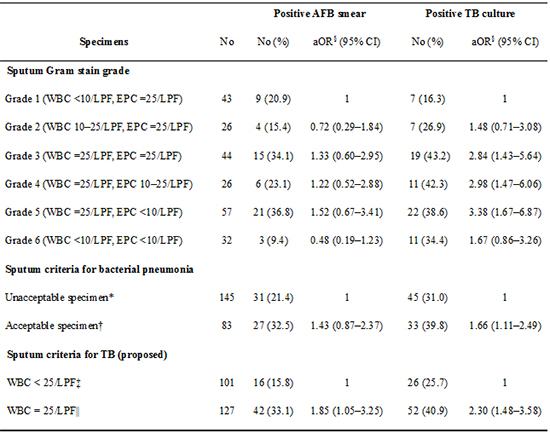1. Murray PR, Washington JA. Microscopic and baceriologic analysis of expectorated sputum. Mayo Clin Proc. 1975; 50:339–344.
2. Rosón B, Carratalà J, Verdaguer R, Dorca J, Manresa F, Gudiol F. Prospective study of the usefulness of sputum Gram stain in the initial approach to community-acquired pneumonia requiring hospitalization. Clin Infect Dis. 2000; 31:869–874.
3. Diagnostic Standards and Classification of Tuberculosis in Adults and Children. This official statement of the American Thoracic Society and the Centers for Disease Control and Prevention was adopted by the ATS Board of Directors, July 1999. This statement was endorsed by the Council of the Infectious Disease Society of America, September 1999. Am J Respir Crit Care Med. 2000; 161:1376–1395.
4. Isaac-Renton JL, Puselja BB, Allen EA, Grzybowski S, Black WA. Microscopic evaluation of sputum specimens submitted for Mycobacterium tuberculosis culture. Am J Clin Pathol. 1985; 84:361–363.
5. Curione CJ Jr, Kaneko GS, Voss JL, Hesse F, Smith RF. Gram stain evaluation of the quality of sputum specimens for mycobacterial culture. J Clin Microbiol. 1977; 5:381–382.
6. Lee YJ, Shin S, Roh EY, Yoon JH, Kim DK, Chung HS, Lee CH. The effectiveness of a brochure describing an acceptable method of sputum collection for tuberculosis testing. Int J Tuberc Lung Dis. 2013; 17:1587–1589.
7. Vieira MO, Pizzichini E, Steidle LJ, da Silva JK, Pizzichini MM. Sputum induction in severe exacerbations of asthma: safety of a modified method. Eur Respir J. 2011; 38:979–980.
8. Veras TN, Pizzichini E, Steidle LJ, Rocha CC, Moritz P, Pizzichini MM. Cellular composition of induced sputum in healthy adults. J Bras Pneumol. 2011; 37:348–353.
9. Singh D, Edwards L, Tal-Singer R, Rennard S. Sputum neutrophils as a biomarker in COPD: findings from the ECLIPSE study. Respir Res. 2010; 11:77.
10. McCarter YS, Robinson A. Quality evaluation of sputum specimens for mycobacterial culture. Am J Clin Pathol. 1996; 105:769–773.
11. Anil N, Singh M, Rajwanshi A, Vohra H. Induced sputum nitrites correlate with FEV1 in children with cystic fibrosis. Acta Paediatr. 2010; 99:711–714.
12. Liesker JJ, Bathoorn E, Postma DS, Vonk JM, Timens W, Kerstjens HA. Sputum inflammation predicts exacerbations after cessation of inhaled corticosteroids in COPD. Respir Med. 2011; 105:1853–1860.
13. Burman WJ, Reves RR. Review of false-positive cultures for Mycobacterium tuberculosis and recommendations for avoiding unnecessary treatment. Clin Infect Dis. 2000; 31:1390–1395.
14. Alisjahbana B, van Crevel R, Danusantoso H, Gartinah T, Soemantri ES, Nelwan RH, van der Meer JW. Better patient instruction for sputum sampling can improve microscopic tuberculosis diagnosis. Int J Tuberc Lung Dis. 2005; 9:814–817.
15. Khan MS, Dar O, Sismanidis C, Shah K, Godfrey-Faussett P. Improvement of tuberculosis case detection and reduction of discrepancies between men and women by simple sputum-submission instructions: a pragmatic randomised controlled trial. Lancet. 2007; 369:1955–1960.
16. Hirooka T, Higuchi T, Tanaka N, Ogura T. The value of proper sputum collection instruction in detection of acid-fast bacillus. Kekkaku. 2004; 79:33–37.
17. Yoon SH, Lee NK, Yim JJ. Impact of sputum gross appearance and volume on smear positivity of pulmonary tuberculosis: a prospective cohort study. BMC Infect Dis. 2012; 12:172.








 PDF
PDF ePub
ePub Citation
Citation Print
Print




 XML Download
XML Download